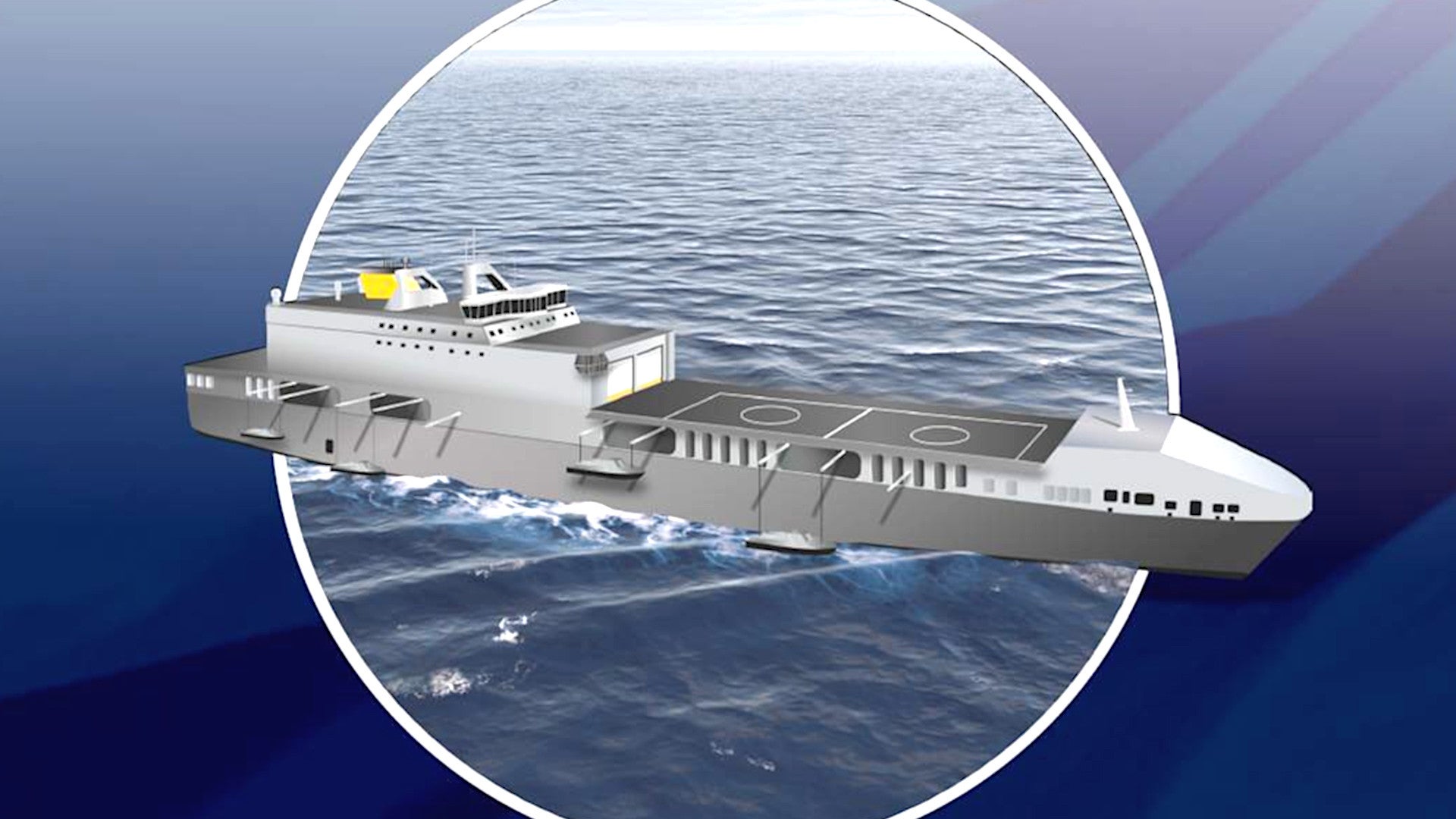The United Kingdom is developing a Future Littoral Strike Ship concept for the Royal Navy, which looks almost identical to the U.S. Navy’s secretive M/V Ocean Trader special operations mothership. The War Zone has been first to report on various sightings and new information regarding this ship in recent years. However, the British vessel’s mission would be to support a broader array of operations, including crisis response and disaster relief, as part of an ambitious plan to reinvigorate the country’s amphibious capabilities.
U.K. Defense Secretary Gavin Williamson announced the Future Littoral Strike Ship (FLSS) plan, as well as associated amphibious developments, in a speech at the Royal United Services Institute (RUSI) think tank on Feb. 11, 2019. Royal Navy Admiral Sir Philip Jones then Tweeted out additional information, along with concept art of the proposed ship. A new “multi-million-pound Transformation Fund” is paying for the FLSS program among other initiatives, according to Williamson.
“[We are] investing now to develop a new Littoral Strike Ship concept. And, if successful, we will look to dramatically accelerate their delivery,” Williamson said in his speech. “These globally deployable, multi-role vessels would be able to conduct a wide range of operations, from crisis support to war-fighting.”
“By accelerating the Future Littoral Strike Ship development via the Transformation Fund, we have the chance for more rapid introduction of this valuable capability into the Fleet, significantly enhancing our ability to act in support of Defence & cross-government objectives,” Jones posted on Twitter.
“Designed to support the unique capabilities of @RoyalMarines Future Commando Force, FLSS offer a dramatic increase in the range, mass & lethality of forces that can be projected from sea to land, delivering decisive military effect anywhere in the world, at a time of our choosing,” he continued.
The ship Jones’ social media post depicts as representative of the FLSS concept is a dead ringer for the aforementioned Ocean Trader. Danish shipbuilder Odense Steel Shipyard originally built this ship in 2011 as a roll-on/roll-off cargo ferry, derived, at least in part, from a design from German shipbuilder Flensburger Schiffbau.
In 2014, the ship, previously known as the Maersk Line’s M/V Craigside, arrived at BAE Systems’ shipyards in Mobile, Alabama for conversion into what the Navy described as a “Maritime Support Vessel.” What this actually meant was gutting the vessel, which displaces some 30,000 tons, and rebuilding it as a special operations sea base.
The result of the $143 million-dollar conversion was dramatic. Ocean Trader has living quarters that can support up to around 200 special operators at a time and can operate independently for up to 45 days.
It can use a ramp at the stern to quickly load and unload vehicles and other cargo in ports or to floating barges. It also has a spacious forward flight deck able to support large helicopters and hangars big enough to hold at least two of them internally.
On the starboard side, there are four hangars capable of launching various small craft, including stealthy speedboats. The ship also received substantial communications and data sharing upgrades, has the ability to launch and recover smaller drones, and much more, all of which you can read about in more detail here and here.
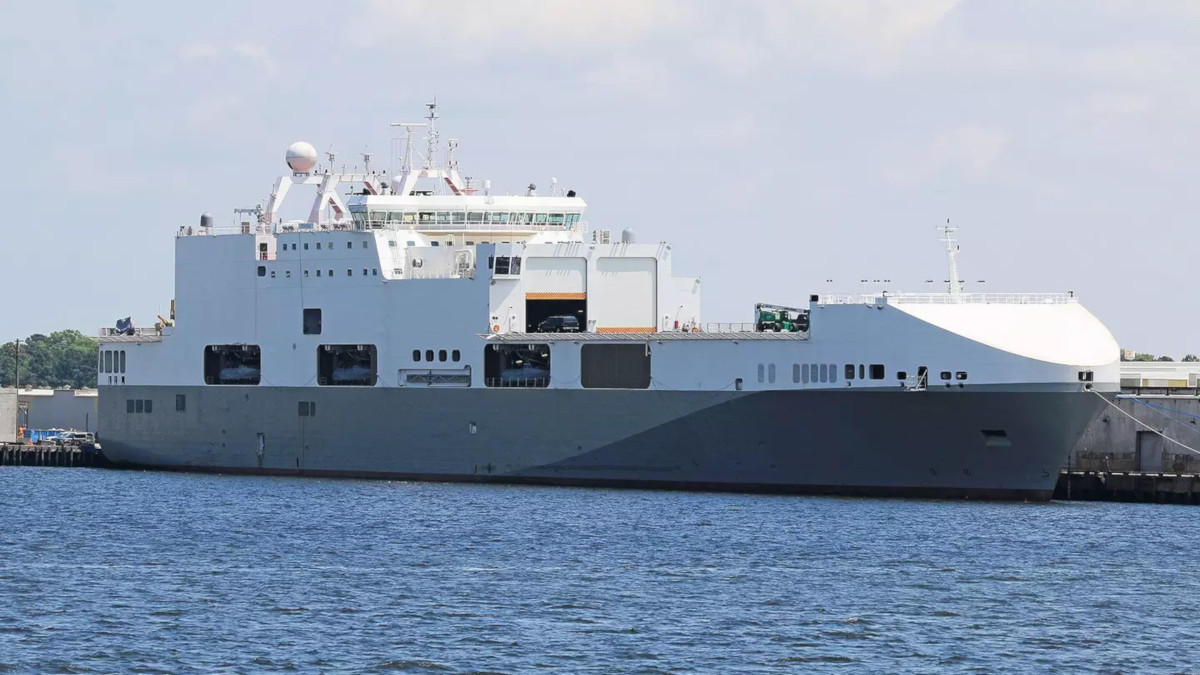
“They [the FLSS] would support our Future Commando Force,” Williamson added, referring to a separate plan to restructure the Royal Marines. “Our world-renowned Royal Marines – they’ll be forward deployed, at exceptionally high readiness, and able to respond at a moment’s notice bringing the fight from sea to land.”
In April 2017, First Sea Lord Jones first announced the overhaul of the Royal Marines, the bulk of which are presently situated within its 3 Commando Brigade, which included a planned ability to deploy specialized “Maritime Operations Commando” task forces in the future. A ship configured along the lines of Ocean Trader would be a logical and cost-effective choice to support this sort of rapid response force and enable it to use both helicopters and small landing craft to get ashore in the absence of readily accessible port facilities.
In 2016, Canada’s Irving Shipbuilding pitched another conversion of a roll-on/roll-off ship similar to Flensburger’s designs, known as the Maritime Support Ship, which was primarily geared toward humanitarian aid and disaster relief missions. The general proposed configuration is also similar to the one BAE delivered to the Navy. Irving said the total cost to the Canadian government would be less than $250 million per ship, making the concept especially attractive as a low-cost option for lower-risk missions.
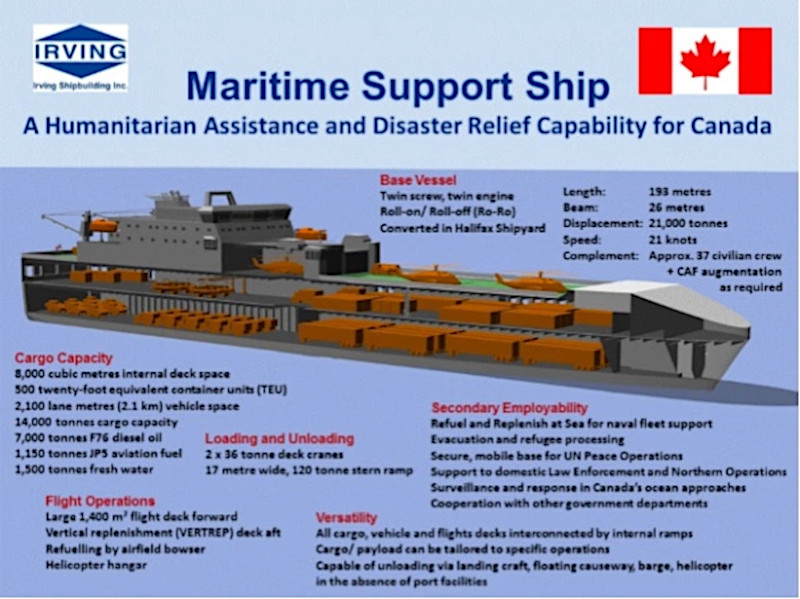
Acquiring an FLSS using BAE Systems’ conversion concept for Flensburger’s designs also makes good sense for the United Kingdom, specifically, which has had access to smaller ships of a similar design known as the Point-class through a Private Finance Initiative since 2002. Flensburger built four of the six ships in this class, while Harland & Wolff in Northern Ireland built the other two. The U.K. Ministry of Defense then signed a deal with Foreland Shipping that it could call upon these vessels as contractor-operated naval auxiliaries in times of need, but that the company can otherwise operate them commercially.
It is possible that the United Kingdom might outright purchase any of the four remaining Point-class ships that it has under contract and convert them into the FLSS configuration. These vessels, which are similar to Ocean Trader displacement and configuration before its conversion, may require more extensive and costly modifications than Ocean Trader due to the broader mission set the U.K. Ministry of Defense has in mind and some slight differences in their design.
But depending on the modularity of the conversion, whatever the exact base ship design turns out to be, the Royal Navy might be able to readily reconfigure the vessel between various combat and non-combat missions. This would give the Royal Navy a more flexible platform, for a relatively low price compared to a more traditional amphibious ship.
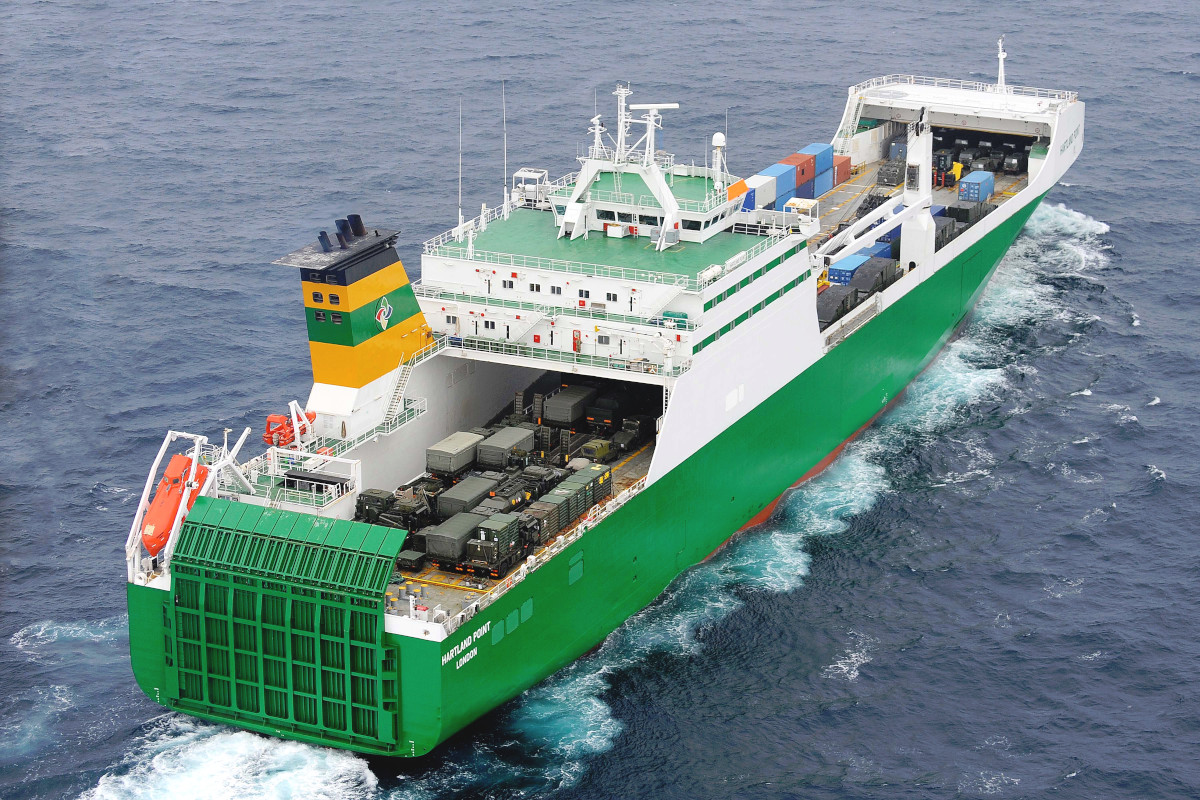
The Point-class ships have already previously served as elements of the Royal Navy-led very-high readiness Joint Expeditionary Force (Maritime), previously known as the Response Force Task Group, but only in the general cargo carrying role. The flagship of these task forces, however, had previously been the helicopter carrier HMS Ocean.
The United Kingdom officially decommissioned Ocean in 2018 and sold her to Brazil. Since then, the Royal Marines have had to rely on the Royal Navy’s two Albion-class landing platform docks and the three Bay-class landing ships. The Royal Fleet Auxiliary (RFA), a civilian mariner service akin to the U.S. Military Sealift Command, operates the latter ships.
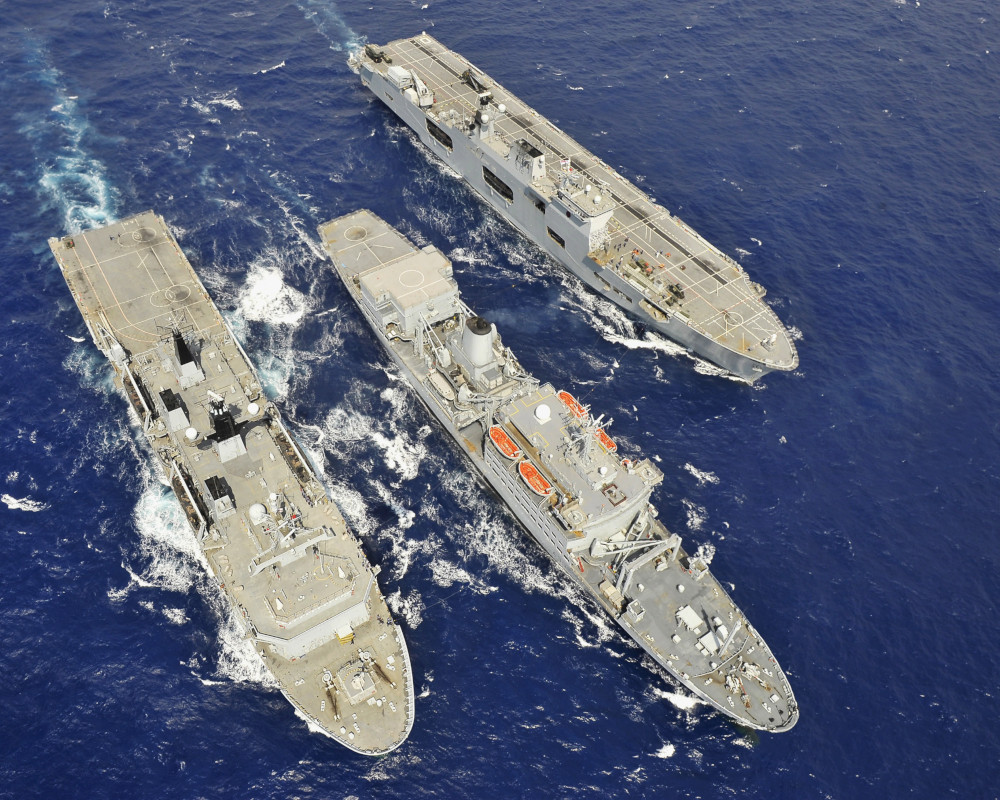
“Our vision is for these ships [the FLSS] to form part of 2 Littoral Strike Groups complete with escorts, support vessels, and helicopters,” Defense Secretary Williamson explained in his speech at RUSI. “One would be based East of Suez in the Indo-Pacific and one based West of Suez in the Mediterranean, Atlantic, and Baltic.”
What Williamson is describing is a lower-end task force for less demanding missions that don’t require larger Joint Expeditionary Force (Maritime) task forces, which could include the Royal Navy’s new supercarrier HMS Queen Elizabeth, and her sister HMS Prince of Wales, in the future. During those missions, the carriers could carry a “Littoral Maneuver” force also consisting of Royal Marines and helicopters.
It’s an ambitious plan, but it is in line with other statements from the British government about plans to expand the U.K. Armed Forces’ operational reach and cooperation with allies and partners abroad, especially in Europe and Asia. Just in January 2019, the Royal Navy conducted drills alongside the U.S. Navy in the highly contested South China Sea to challenge Chinese claims over the region. The first operational deployment for country’s new supercarrier HMS Queen Elizabeth, scheduled to occur in 2021, will include trips to the Mediterranean, Middle East, Pacific region “making global Britain a reality,” Williams also said in his speech.
The Defense Secretary’s comments also reflect a significant change in tone regarding the U.K. armed forces amphibious capabilities. In 2017, there were reports that the Ministry of Defense might have to cut the more than 8,000-strong Royal Marines’ overall size by more than 10 percent and retire the two Albion class amphibious ships to help pay for other priorities, most notably the Royal Navy’s pair of Queen Elizabeth-class carriers. Williamson did not speak directly to the future of the Albions or the total size of the Royal Marines, but did say that the existing two amphibious ships were still part of broader plans for British amphibious capability going forward.
In addition, though Defense Secretary Williamson and First Sea Lord Jones did not specifically mention it in their respective comments, the FLSS would also be ideally suited to serving as a floating launch platform for special operations missions. U.K. special operations forces, such as the elite Special Air Service and Special Boat Service, routinely train and otherwise liaise with their American counterparts and it is very likely that they at least have a good understanding of Ocean Trader’s capabilities, if they haven’t actually spent time on board the vessel.
Still, it remains to be seen how far the United Kingdom will actually pursue the FLSS program and how many ships it might acquire in total. Williamson was very careful in his speech to hedge that the plan was very much conceptual at present and might not proceed if it doesn’t meet the Ministry of Defense’s expectations.
While the FLSS concept certainly aims to be cost-conscious, the ships themselves are unlikely to be able to provide a particularly robust amphibious capability. Ocean Trader can only hold 200 special operators after its conversion. By comparison, the Albion-class ships can carry a standard complement of more than 400 Royal Marines, and more than 700 if absolutely necessary, and they also have a well deck to carry more readily launch amphibious vehicles and larger landing craft.

As converted roll-on, roll-off ships originally built to commercial standards, they would be more vulnerable to hostile fire and battle damage. With a smaller crew more in line with commercial vessels than warships, dealing with that damage also becomes a major issue.
At present, there is no indication from the concept art that the proposed ship would have anything but the most minimal defenses. Ocean Trader, for instance, is only equipped with machine guns for force protection. Increasingly advanced anti-ship missiles, naval mines, and other threats, which are steadily proliferating even to non-state actors, would pose a serious risk to a similar ship operating in an amphibious assault combat environment. This is true even inside a larger task force, but especially during more independent operations with minimal or no escorts.
As such, there is also a very real question about how realistic the proposal for two new standing, forward-based Littoral Strike Groups actually is for the United Kingdom, especially in light of economic concerns surrounding the impending departure of the country from the European Union. At present, the core of the Royal Navy’s surface fleet consists of six Type 45 destroyers and 13 Type 23 frigates.
Even if each Littoral Strike Group only has just one frigate assigned to it as an escort, this means that 15 percent of the Royal Navy’s entire Type 23 fleet would be otherwise unavailable for other missions. The service has already had difficulty keeping up the availability rates of these ships due to their advancing age and personnel shortages. Combined with the simple need for routine maintenance, all 13 of the ships are unlikely to be available for deployments at any one time.
Without escorts permanently in place, it could be difficult for the United Kingdom to rapidly deploy the FLSS to anywhere but the most low-risk conflict areas around the globe. This is not much of a concern for a special operations focused mothership, but it is for one tasked with traditional amphibious operations.

This is before taking into account the Royal Navy’s emerging requirements for escorts and other ships to assist the Queen Elizabeth-class carriers on their deployments. A typical U.S. carrier strike group includes a Ticonderoga-class guided-missile cruiser, three Arleigh Burke-class destroyers, and at least one Los Angeles-class attack submarine. In an attempt to mitigate this issue, the United Kingdom has already made arrangements with allies to provide additional capacity during the flattop’s first patrol.
The Royal Navy is planning to replace the aging Type 23s, but with eight new Type 26 and five Type 31e frigates, which will not grow the overall size of the service’s surface fleet. Those ships are still years away from entering service and the United Kingdom hasn’t even picked a final Type 31e design. None of this will alleviate the issues of recruitment and retention of sailors to man these ships, either.
Even with these issues to contend with, Williamson was right to note the demand for increased amphibious operations capacity in his speech at RUSI. The FLSS concept certainly could help fill in some capacity gaps, at least for certain operational requirements, even though going with a converted commercial ship design for the demanding amphibious operations mission set will inject higher operational risk. Providing a proper surface combatant escort for these vessels will be key and that won’t be easy considering the tasking and availability issues the Royal Navy already is dealing with in regards to its relatively small surface combatant fleet.
Still, letting these ships do some of the lower-end tasks might help free up the Albions, the Royal Navy’s new carriers, and other ships for more demanding amphibious missions. When a major amphibious operation is necessary, these converted vessels can augment those vessels and other Royal Navy fighting ships as part of an overall task force that will come with plenty of escort firepower.
But it remains to be seen whether the Royal Navy will have the other resources necessary to make the most of the added capabilities these new ships would have to offer. Then again, there is probably just as much of a case for the Ministry of Defense investing in at least one of these unique vessels for special operations focused missions with amphibious support and disaster relief as secondary functions.
The country has some of the finest capabilities in the world in this regard. Pushing those capabilities out to sea on a specially modified, but somewhat affordable mothership seems like an equally attractive proposition.
Contact the author: jtrevithickpr@gmail.com
